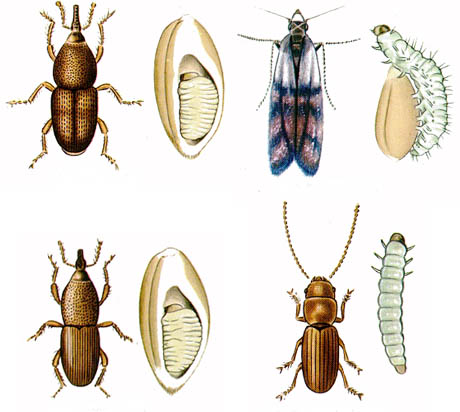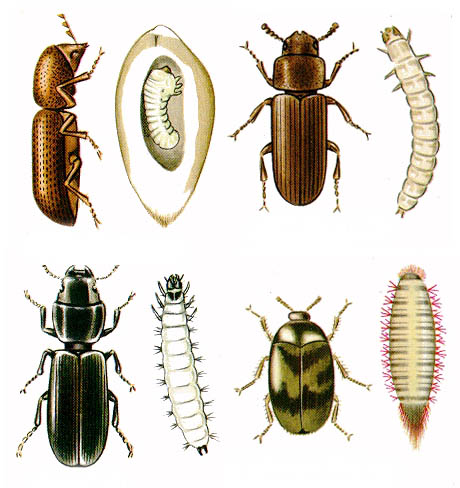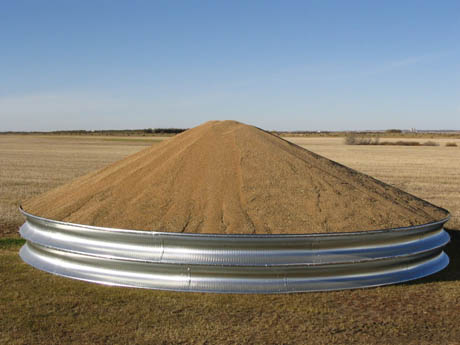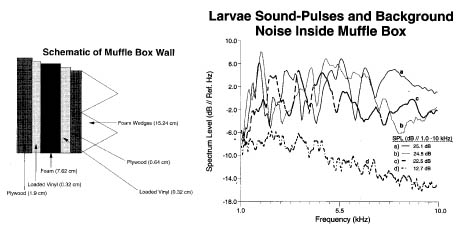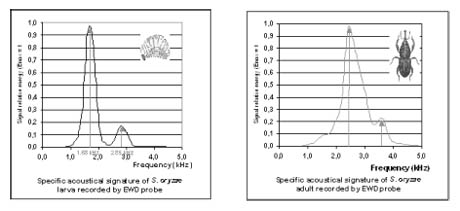Deep in the archives of San Francisco-based Aquarius Records, buried between several days’ worth of “laptop glitchery” and “brutal industro-crunch,” lies this gem: Insect Noise in Stored Foodstuffs, (INRA, 2000, CD, 19:98).
IMAGE: Common stored grain pests, not shown to scale. Left to right, top to bottom: Rice weevil, Indian meal moth, Granary weevil and Flat grain beetle. Drawings via the University of Missouri guide to stored grain pests.
The CD is currently unavailable or out of stock, which is disappointing but unsurprising, given its intriguing description:
Insect Noise in Stored Foodstuffs appears to be an industrial document produced by the 5th International Working Conference On Stored-Product Protection. This CD presents the sound investigation of the French team of Bunsel and Andrieu who used sensitive microphones with narrow frequency responses made to detect and identify the sounds of insect larvae which may be inhabiting otherwise quiet containers of grains and cereals.
A handful of examples of the sounds including the grain weevil, the Indian meal moth, and the Lesser mealworm are accompanied by a running narrative both explaining the techniques used and the identification of the insects. And in case you missed the first 30 minutes of the document, the kind people at the 5th International Working Conference On Stored-Product Protection repeat the program in French.
Mysteriously, the online proceedings of the 5th International Working Conference of Stored Product Protection (IWCSPP) do not include reference to any such CD. However, in Session 8, there is a short paper entitled “Automated acoustical detection of stored-grain insects and its potential in reducing insect problems,” by D. W. Hagstrum.
IMAGE: More common stored grain pests, not shown to scale. Left to right, top to bottom: Lesser grain borer, Red flour beetle, Cadelle, and Larger cabinet beetle. Drawings via the University of Missouri guide to stored grain pests.
From that teasing clue, it is just a short step into the world of acoustic pest detection. David Hagstrum, as it turns out, is the co-author of a major textbook on the subject of food infestation control. His 323-page Fundamentals of Stored Product Entomology, published in 2008 by the American Association of Cereal Chemists, includes a chapter specially devoted to the subject of designing an effective acoustic sampling programme.
Silos, bins, elevators, or UFO-like grain storage rings filled with wheat, oats, barley, or sorghum make an understandably attractive home for a number of insects and their larvae. The problem, as outlined by Francis Fleurat-Lessard in a paper submitted to the 9th IWCSPP, is that while “the presence of live insects in commercial grain lots is unacceptable in grain trade,” standard techniques of insect detection are slow, inaccurate, labour-intensive, expensive, or all of the above.
IMAGE: Grain Storage Ring. Photo courtesy Behlen Industries LP.
The U.S. Grain Inspection Service, Packers, and Stockyard Admininstration’s (GISPSA) standard quality assessment method involves sieving and visually inspecting a one kilogram sample: their guidelines “consider grains infested if the representative sample contains two or more live weevils, or one live weevil and one or more other live insects injurious to stored grain, or two or more live insects injurious to stored grain.”
However, since the larvae of many stored product pests grow inside grain kernels, where, Fleurat-Lessard notes, their “population density may be ten times more numerous than free-living adults,” a visually-inspected “clean” sample may actually be completely infested with rice weevil larvae. To look inside grains, laboratories use X-rays or resonance spectroscopy, but these techniques are too expensive and impractical to deploy in bulk grain lots.
But while rice weevil larvae are invisible, they are not inaudible: the “mean sound pressure” of rice weevil larvae feeding inside a wheat kernel is 23 dB, according to the USDA Agricultural Research Service. The idea, then, is that if you could somehow design sensitive-enough acoustic probes, combined with software to match the probes’ input against a database of field recordings, you might be able to monitor insect activity in stored grain automatically and detect infestations at the larval stage.
A fairly select group of entomologists, including several specialists at the USDA’s Insect Behavior and Biocontrol Research Unit, have thus spent the past twenty years investigating the acoustic detection of insect noise. Major steps forward, as described by Fleurat-Lessard, came with the development of ever more sensitive sound technology, as well as innovative designs for “muffle boxes” that shield acoustic sensors in grain bins.
IMAGE: (left) Muffle box diagram, (right) Periodograms of sonic output from three different rice weevil larvae recorded using muffle box-shielded acoustic sensors. The lowest line records background noise levels. Diagrams from “Noise Shielding of Acoustic Devices for Insect Detection,” in the Journal of Economic Entomology.
Building a sound library of stored food insects was equally important – the field recordings on that Insect Noise in Stored Foodstuffs CD actually form the core of current acoustic pest detection databases. Years of research have gone into classifying the characteristic sonic signatures of different pest species at different stages in their lifecycles, to the point that a computer can now compare input from a grain silo’s acoustic sensor system against a library field recordings and tell you whether the rice weevil larvae eating your wheat kernels are sixteen or eighteen days old.
(For the curious, you can actually listen to the fairly revolting munching sounds of Indian meal moth and eighteen-day-old rice weevil larvae at the USDA website.)
IMAGE: Characteristic sound spectra of rice weevil larvae (left) and adults (right) in wheat. Diagrams via Francis Fleurat-Lessard’s paper, “Acoustic detection and automatic identification of insect stages activity in grain bulks by noise spectra processing through classification algorithms,” presented at the 9th International Working Conference on Stored Product Protection.
Other refinements include using algorithms to gauge pest population density and even location: the USDA’s ALFID, or Acoustic Location “Fingerprinting” Insect Detector “has a 90% probability of identifying two randomly located insects producing sounds in a wheat sample.”
IMAGE: Technicians holding an ALFID in an anechoic chamber. Photo by Keith Waller, via USDA research entomologist Richard Mankin.
In short, there is an entire sonic landscape of pests eating stored foods: a distinctive range of muffled boring, tapping, scraping, and crunching sounds emerging from supposedly silent grain elevators across the country.
But with acoustic pest detection in place, acoustic control cannot be far behind. Ultrasonic cockroach repellers and pigeon dispersal soundtracks lead the way in bio-acoustic pest management: the latter broadcasts pre-recorded pigeon distress calls that “harness the bird’s own inbuilt messaging to perform psychological warfare against them.”
IMAGE: The LRAD (Long Range Acoustic Device) acoustic cannon mounted on a U.S. Navy vessel. According to Wikipedia, it emits a sound loud enough to cause permanent hearing loss and temporary disruption of vision, and has already been deployed against Somali pirate attacks and insurgents in Fallujah, Iraq. Photo via Wikipedia.
Perhaps the USDA could team up with its military cousins to invent a Confused flour beetle-specific LRAD-equivalent, in order to replace fumigants like aluminium phosphide and methoxychlor? With sound-defended food storage in place, ultimately the entire chain of food production could be acoustically enhanced, from sonically stimulated GM rice to taste-amplifying meal soundtracks.
NOTE: Thanks to BLDGBLOG‘s Geoff Manaugh, who originally showed me the Insect Noise in Stored Foodstuffs description at Aquarius Records’ site.

